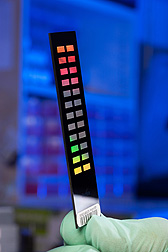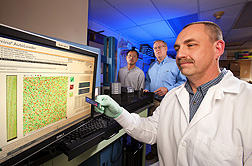New Tool for Improving Soybeans
For all that was gained when soybeans were domesticated thousands of years ago, scientists believe that something was lost: valuable genes left out of today’s cultivated varieties that could make them more productive and better able to resist the pests and diseases that are constant threats. Perry Cregan, Qijian Song, and Charles Quigley, who are with the Agricultural Research Service’s Soybean Genomics Laboratory in Beltsville, Maryland, have developed a tool to help in the search for regions of the soybean genome where those useful genes could still be found.
The tool is a glass chip with a difficult name: the SoySNP50K iSelect SNP BeadChip. It’s about 3 inches long and has an etched surface that holds thousands of DNA markers, which can be deciphered by computers and used by scientists to characterize the genomes of large numbers of soybean plants.
If researchers at ARS and elsewhere scan enough soybean plants, they should be able to discover previously unknown genes associated with important characteristics. The chip will speed up those searches. Genetic information that once took days or weeks to collect can be gathered in about 20 minutes, Quigley says.
To create the chip, the group analyzed and compared the DNA of six cultivated and two wild soybean plants to identify single nucleotide polymorphisms (SNPs), a type of molecular marker often used by scientists working with DNA. They compared SNPs from the eight soybean plants with sequences of a cultivated soybean variety, Williams 82, and came up with thousands of candidate SNPs to use as signposts when comparing the genes of different soybean plants at thousands of positions along their chromosomes.
Ultimately, they distilled the candidates down to 60,800 SNPs and sent them to Illumina, Inc., the California technology firm that used the data to create the beadchip. Another team of ARS scientists worked with Illumina several years ago to create a chip for identifying genetic markers in cattle.
The researchers have already used the soybean chip to profile 96 wild and 96 cultivated soybean varieties by comparing SNP alleles, or variant forms, at each of their 52,000 positions on the genome, as registered on the chip. The information allowed them to identify regions of the soybean’s genome that played a key role in the plant’s domestication. Results were published in a paper in PLOS One in January 2013.
They also used the chip to analyze the 18,484 cultivated soybean accessions and 1,168 wild soybean accessions in the USDA Soybean Germplasm Collection at Urbana, Illinois, and submitted the data to SoyBase, the USDA-ARS soybean genetics and genomics database, so it can be accessed by breeders and geneticists. The work received support from the grower-funded United Soybean Board Checkoff.—By Dennis O'Brien, Agricultural Research Service Information Staff.
The research is part of Plant Genetic Resources, Genomics, and Genetic Improvement, an ARS national program (#301) described at www.nps.ars.usda.gov.
Perry Cregan, Qijian Song, and Charles Quigley are with the USDA-ARS Soybean Genomics and Improvement Laboratory, 10300 Baltimore Ave., Beltsville, MD 20705-2350; (301) 504-5723 [Cregan], (301) 504-5337 [Song], (301) 504-5751 [Quigley].
"New Tool for Improving Soybeans" was published in the February 2014 issue of Agricultural Research magazine.








